Case Report
A 13-year-old female patient reported to the Department of Pedodontics and Preventive Dentistry, with the complaint of poor aesthetics, missing lower front teeth and difficulty in speech due to restriction of tongue movements. Parents also informed about her low self-esteem. On oral examination all permanent mandibular anterior teeth including central and lateral incisors and canines (31,32,33,41,42,43) were missing. Ankyloglossia was also noted [Table/Fig-1].
Preoperative photograph showing missing lower anterior teeth and Ankyloglossia (Heart shaped tongue tip).
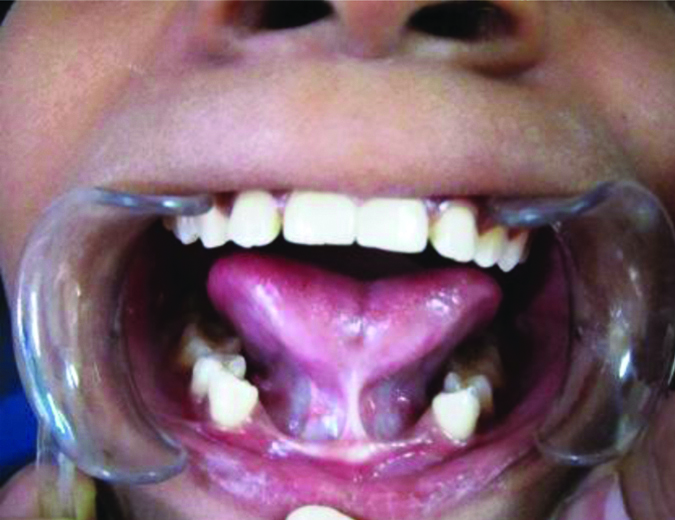
Tongue movements were restricted and difficulty in speech was also noticed. Patient’s parents gave history of eruption of deciduous mandibular central incisors at the age of seven months which were eventually exfoliated at the age of nine years due to trauma. According to Hazel bakers assessment tool the function score was nine and appearance score was five [1]. According to Kotlow A classification patient had moderate ankyloglossia with 10 mm of free tongue length [2]. Medical, past dental and family history were not remarkable.
Orthopantomograph (OPG) and complete blood investigations were done to rule out dental and systemic anomalies. Haematologic examination of the patients was within normal range. In the OPG it was noted that mandibular permanent incisors, canines and all wisdom teeth were missing [Table/Fig-2].
The orthopantomograph showing missing mandibular permanent incisors and canines and all wisdom teeth.
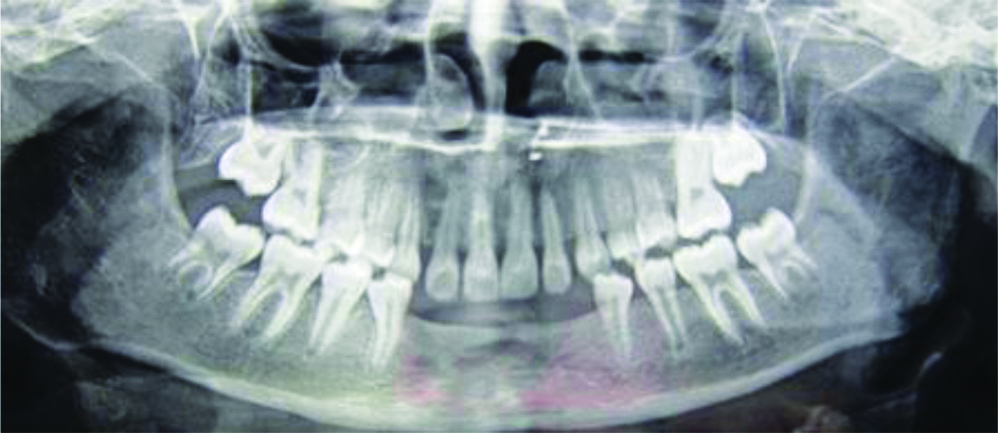
Comprehensive treatment plan was devised with surgical, corrective and maintenance phase that included lingual frenectomy with postoperative exercises, interim prosthesis, periodic recall and definitive implant prosthesis.
Lingual frenectomy: Under all aseptic precautions and with prior written consent of parents, lingual frenectomy was performed under local anaesthesia. During this procedure, after anaesthesia, the tip of the tongue was lifted employing a suture thread so as to expose the frenum. Two haemostats were used to clamp the frenum with their tips meeting in the deep aspect near the base of the tongue, one below the surface of the tongue and another at the floor of the mouth avoiding salivary gland ducts respectively. Incision was placed with sterile blade no 15. above and below the haemostats to release the complete frenum. The incision extended from the thinnest portion between the tongue and therefore the gum ridge into the sulcus just proximal to the genioglossus muscle [Table/Fig-3]. After the release, 4-0 non resorbable silk sutures were placed [Table/Fig-4].
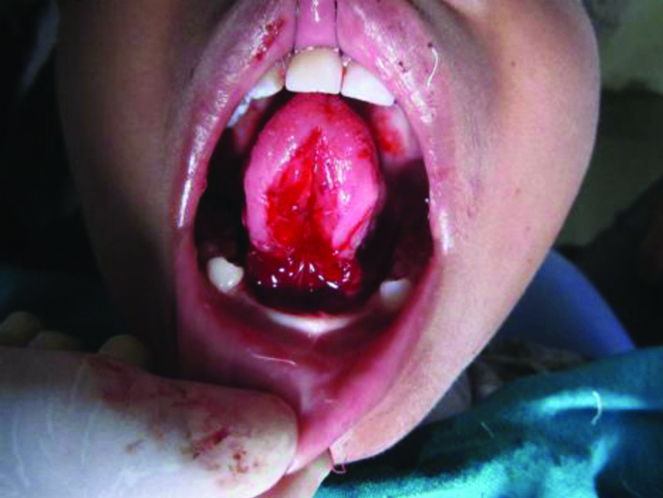
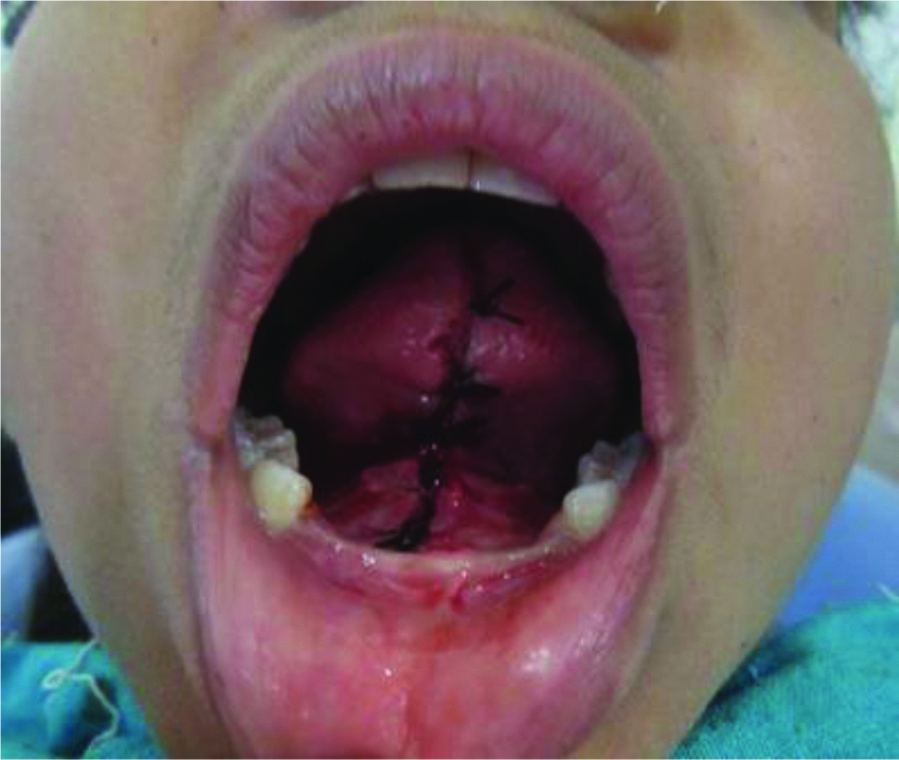
Postoperative exercises: Patient was asked to perform vigorous tongue exercises designed to improve protrusion, elevation, and side-to-side motion three or more times daily postoperatively to compensate for muscle contracture and improve tongue range motion. Immediate short-term follow-up was performed after seven days for suture removal. One week postoperative review of operated site revealed complete wound healing and free tongue movement [Table/Fig-5].
Improved tongue movement after frenectomy.
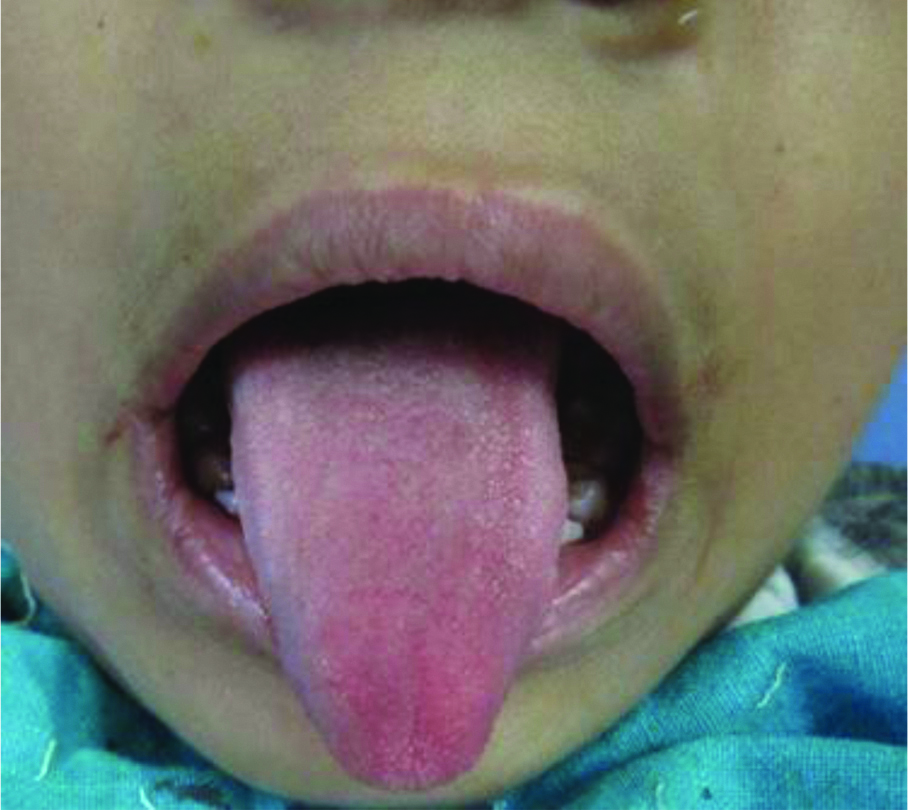
Interim prosthesis: Patient and her parents insisted on definitive prosthetic treatment like implants. However, considering the young age of the patient an interim fixed prosthesis in the form of an aesthetic functional fixed space maintainer was planned, fabricated and delivered in lower anterior region in between the recall visits [Table/Fig-6].
Functional Space Maintainer in mandibular anterior region.
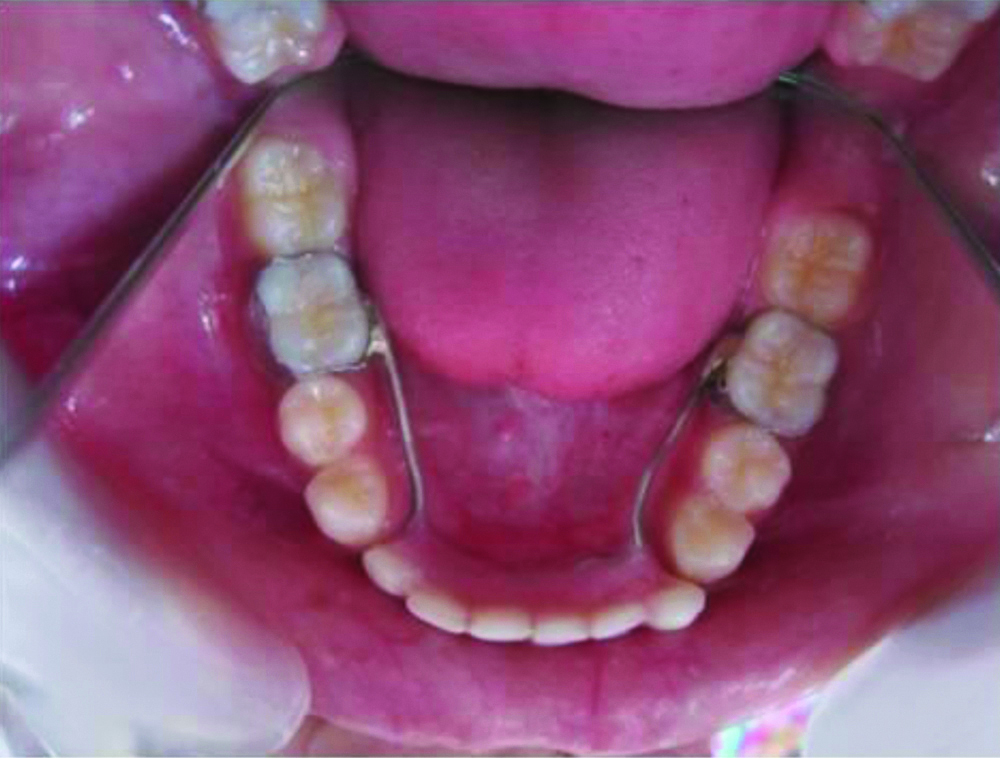
Periodic recall and definitive implant prosthesis: Recall visits were scheduled for every three months, with a long-term follow-up duration of three years. Patient reported regularly for check-up as well as for definitive prosthetic treatment. Hence, implant prosthesis was planned for the patient at the age of 16 and accordingly necessary radiographic investigation of mandibular anterior region was done for prosthetic treatment. Cone Beam Computerised Tomography (CBCT) of 31, 32, 33, 41, 42, 43 region was done and with necessary blood investigations surgical phase of implants placement was performed under aseptic precautions. Decisions regarding implant length and width were supported by CBCT of the mandibular anterior bone [Table/Fig-7].
Cone beam computed tomography image measuring implant length and width.
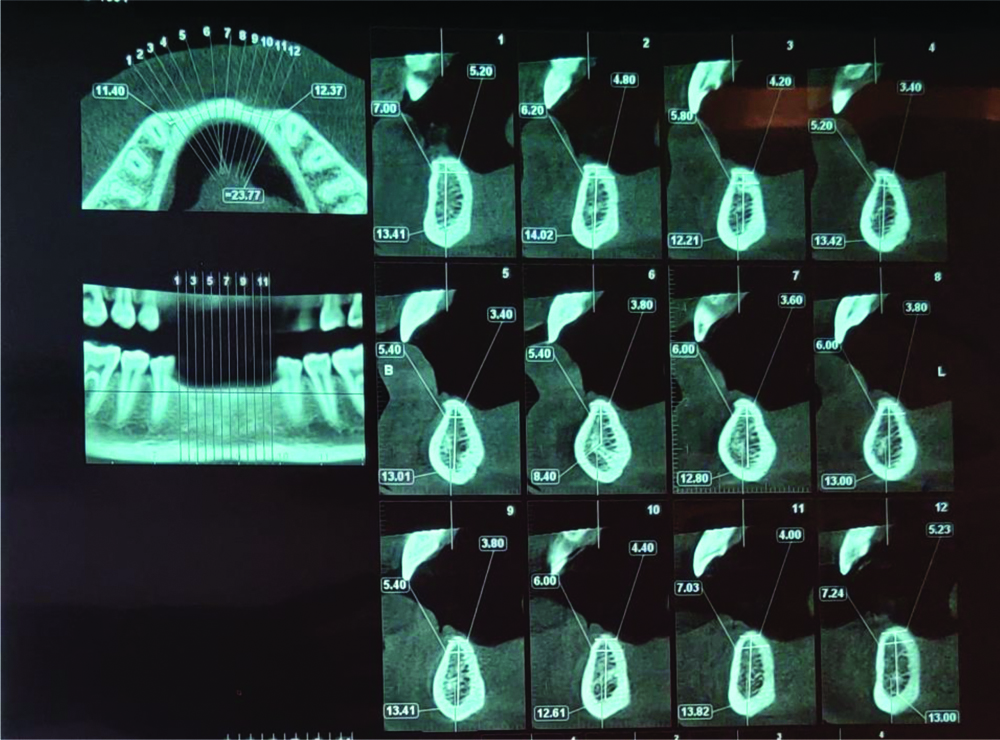
Bone density in this region was D2 type. The edentulous span necessitated placement of three implants to maintain the inter-implant distance of 3 mm to counteract bone loss. Three implants were planned at equidistance, CBCT sagittal slice was taken at section 3 (Implant 1), section 7 (Implant 2), and section 11 (Implant 3). The ridge width and height of bone at the level of the crest was 4.2 mm and 12.21 mm (Implant 1), the ridge width and height 2 mm below the level of the crest was 6 mm and 12.80 mm (Implant 2), the ridge width and height 2 mm below the level of the crest was 7.03 mm and 13.82 mm (Implant 3). The implant surgery was undertaken after administering local anaesthesia. Intraoral crestal incision was given with blade no.15. Mucoperiosteal flap was raised; flattening of the alveolar crest was performed with a rose head carbide bur and under copious normal saline irrigation.
At insertion, the implants were placed at a depth consistent with the rules given by the manufacturer (Adin Implants, Straumann), Osteotomy site was prepared in CBCT section 3, 7 and 11, to place self-tap three implants of dimensions 3.5×11.5 mm single piece using pilot drill followed by 2.8 mm diameter drill. Three self tap implants were placed in CBCT section 3, 7 and 11 (the all three implants were 3.5 mm in diameter and 11.5 mm in length [Table/Fig-8a,b]. The flap was closely approximated using 3-0 black silk sutures. Antibiotics (Amoxicillin+Clavulanic acid 625 mg, BD for five days) and analgesics (Ibuprofen+paracetamol, BD for three days) were prescribed. 0.2% chlorhexidine rinse was prescribed to use every three hours for one week and twice daily for following two weeks postoperatively. Sutures were removed after one week of surgery. Standard oral hygiene instructions were given.
Intraoperative photograph of the patient during implants insertion.
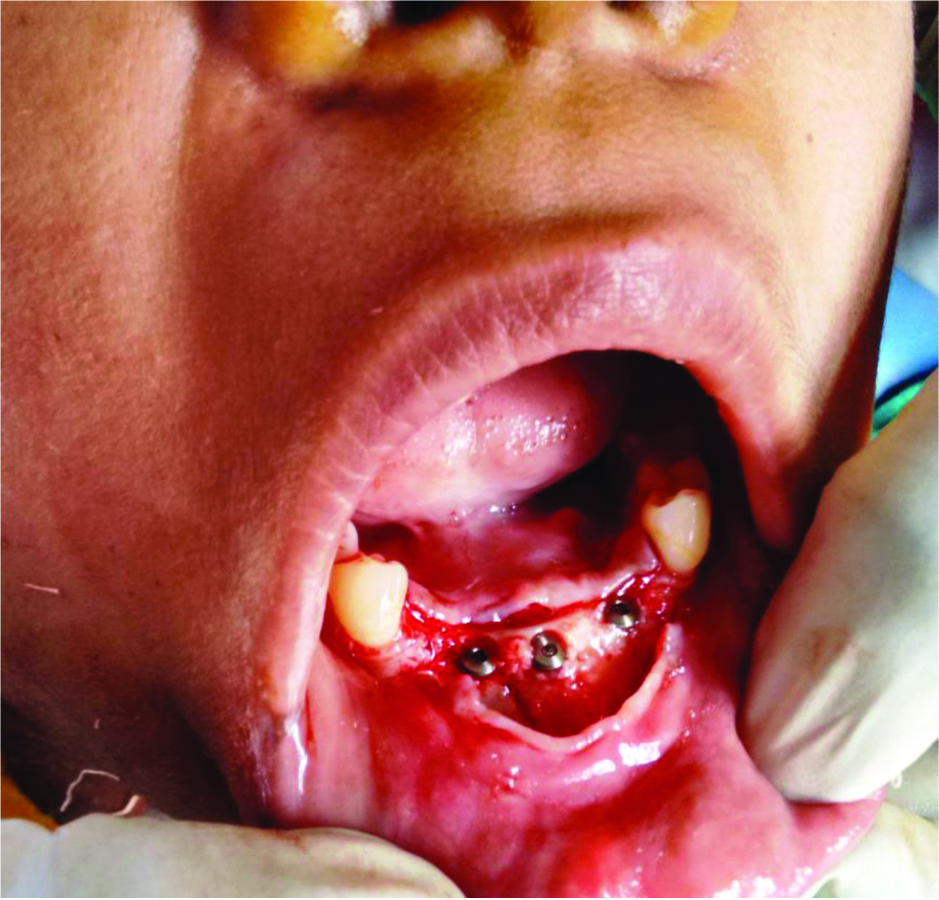
Radiograph (IOPA) showing three implants insertion.
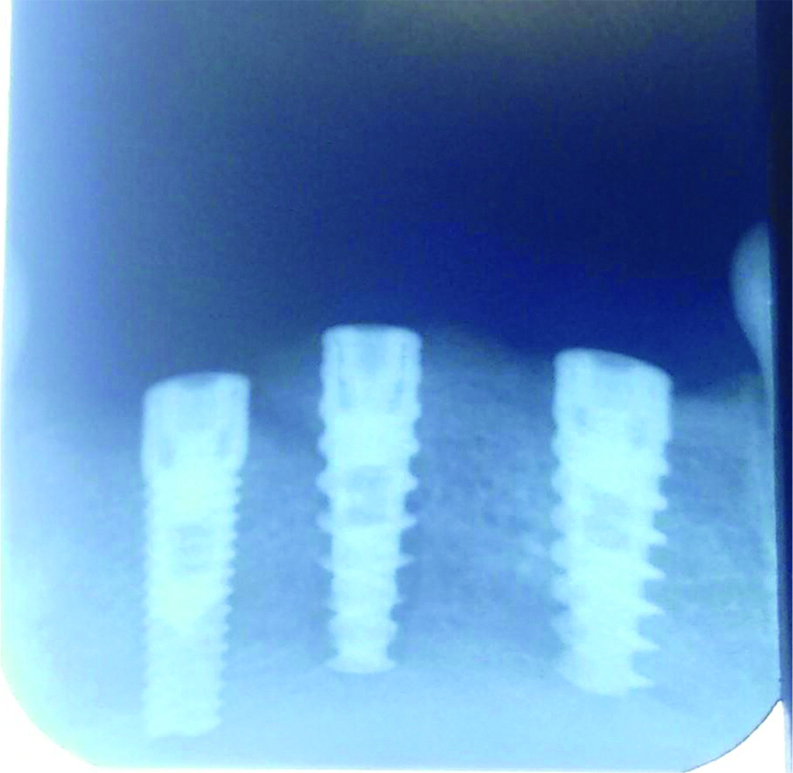
After the osseointegration period, a second-stage surgery was undertaken; the healing abutments were connected and left in place for three weeks for peri-implant soft-tissue healing. The right vertical dimension of occlusion is decided by using the physiologic rest position of the mandible as a guide, the impression copings were placed.
Definitive impressions of the maxillary and mandibular teeth and abutments were made with a polyether impression material. The impression copings were fixed onto the abutment analog. Wax pattern of six units was prepared [Table/Fig-9]. Prosthesis was fabricated on abutment level models from a base metal alloy (Master-Tec, Ivoclar Vivadent AG, Schaan, Liechtenstein) and porcelain (VITA VM 13, VITA Zahnfabrik and cementation was done to retain the six unit implant supported fixed prosthesis [Table/Fig-10a,b] cemented to the abutments. Consent was obtained from the patient for the images that have been presented.
Wax pattern of six unit implant supported prosthesis.
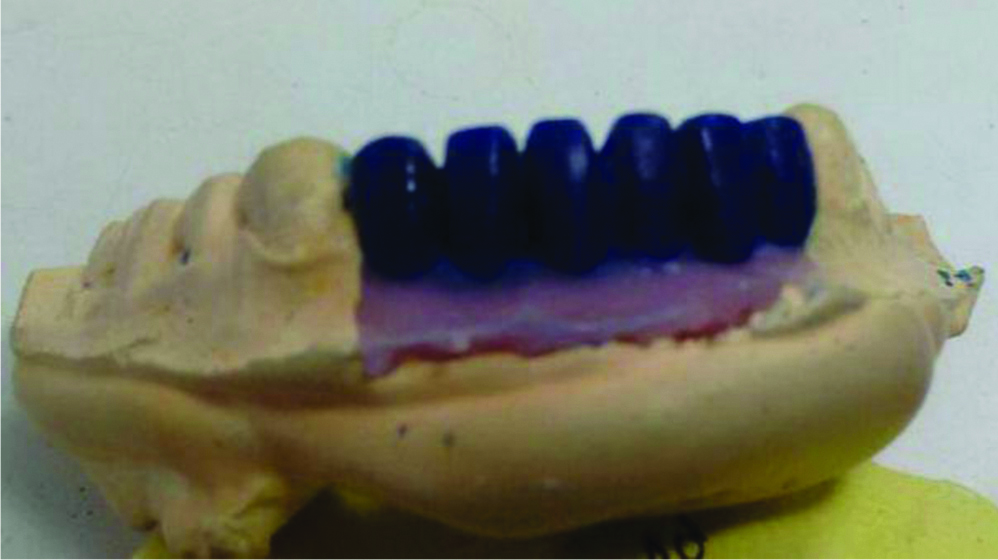
Intraoral view of the patient after delivery of implant supported prosthesis.
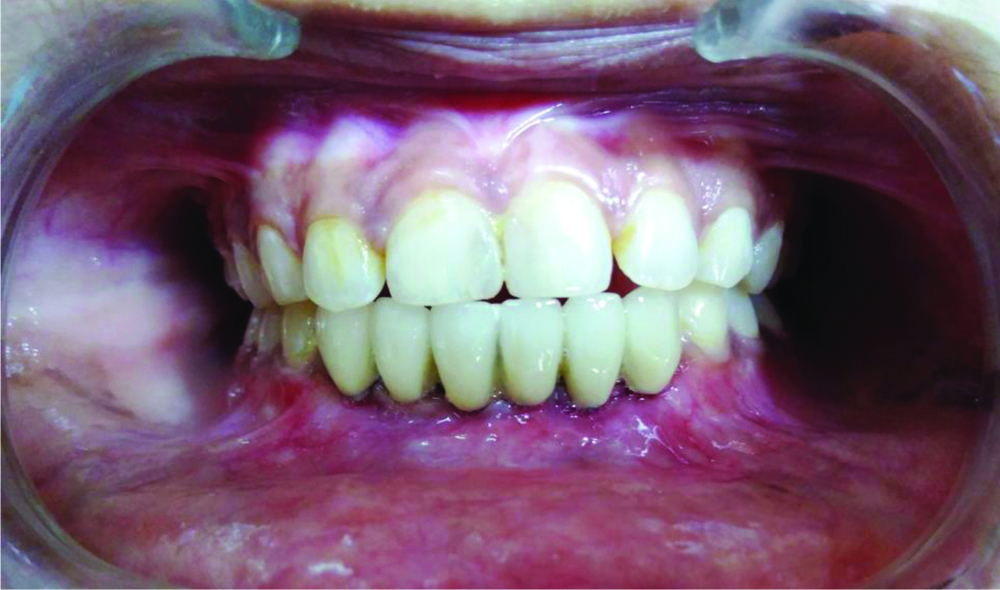
Intraoral view of the patient after delivery of implant supported prosthesis.
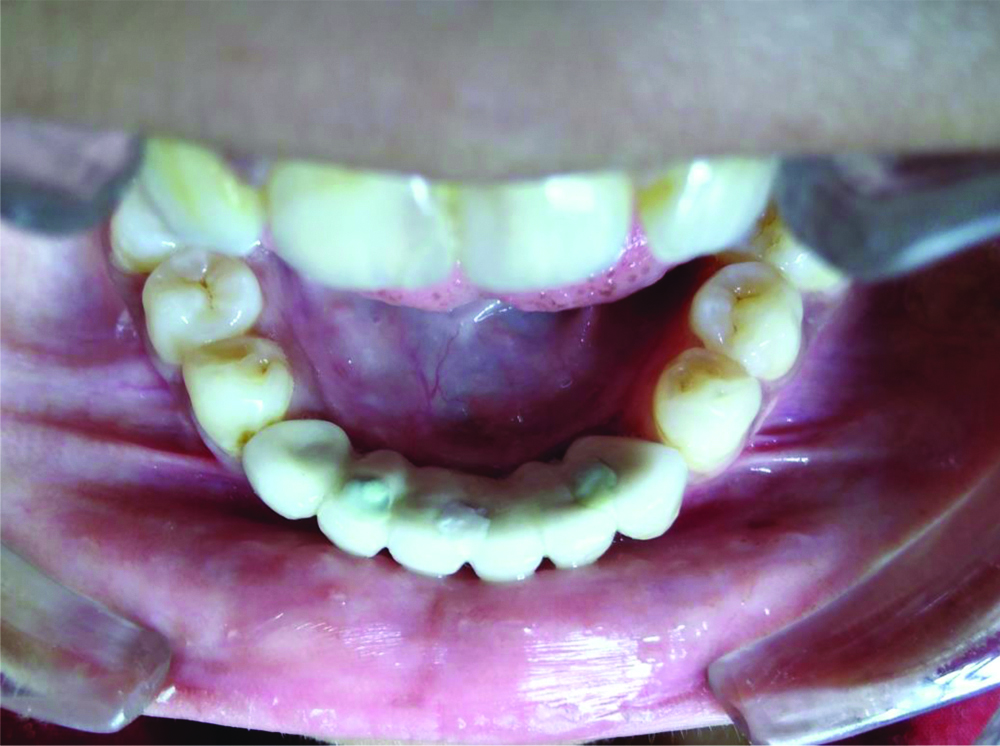
Follow-up
Follow-up was done for the primary year after treatment, the patient was called for a follow-up for routine hygiene check up and assessment of long-term outcomes. The patient acknowledged having improved function and esthetics, and she was satisfied with the results.
Discussion
Ankyloglossia is a rare genetic disorder resulting in the attachment of lingual frenum to the floor of the mouth. Incidence of nonsyndromic presentation of Ankyloglossia is up to 10% [3]. The prevalence of tongue tie is found to be higher in boys when compared with girls with ratios varying from 1.5:1 to 2.6:1 [4].
Tongue tie can cause restricted tongue movements and interferes with speech articulation which was consistent with the findings of our case [3]. Tongue tie can interfere with mandibular growth which can cause mandibular abnormaliities and affect the child’s physical appearance and affect them psychologically [5].
Kotlow A classified tongue tie as Class I (Mild Ankyloglossia: 12-16 mm), Class II (Moderate Ankyloglossia: 8-11 mm), Class III (Severe Ankyloglossia: 3-7 mm) and Class IV (Complete Ankyloglossia: Less than 3 mm) [2]. In this case the patient had moderate ankyloglossia with 10 mm of free tongue length.
Surgical techniques for tongue ties can be classified into three procedures. Frenotomy, frenectomy and revision of frenum by various methods like laser, electrocautery or monopolar diathermy [6]. In our case we performed a conventional technique in which excision of the frenum was done by a scalpel blade no.15.
Hypodontia is a condition with congenitally missing one or two permanent teeth, or oligodontia/partial anodontia is the congenital absence of more than six teeth excluding third molars. It mostly affects the permanent dentition [7].
Studies and researches in genetic linkages and biology have identified mutations within the genes could also be the causative factor in syndromic and nonsyndromic tooth agenesis. Mutations within the MSX1 or the PAX9 genes are identified as a possible cause for non syndromic oligodontia [8].
Oligodontia exhibits higher frequency in females [9]. Congenital absence of teeth mostly in the anterior region usually cause a dental and facial disfigurement, which might lead to social isolation and low self esteem in the child [10]. In such cases, the various treatment modalities are fixed prosthetic, removable prosthetic or implant supported prosthetic treatment. Disadvantage of removable partial denture is that it needs to be replaced due to continued growth [11].
Before the definitive treatment interim prosthesis should be provided for functional as well as aesthetic purpose which will increase the confidence in the child. In this case there were missing mandibular anterior teeth which caused unaesthetic smile and difficulty in biting. So, the interim fixed functional aesthetic space maintainer was given to prevent the social stigma.
Nowadays accepted treatment modality by the patient and the clinician is implant supported prosthesis as the anterior part of the mandible is the ideal site of implant placement since the transverse growth is stable starting the age of six [12].
In the present case report, endosseous implants were placed in the mandible anterior to the mental foramen and a conventional, cement-retained, fixed-implant supported prosthesis was given to allow normal masticatory and phonetic function.
Conclusion(s)
Unusual facial features created by oligodontia in anterior region may be aggravated by associated tongue tie along with impairment of oral functions to exacerbate social challenges particularly in school going age. Early diagnosis and intervention in ankyloglossia and teeth agenesis are fundamental for the subsequent morpho-functional development of the child. Hence, patients with developmental anomalies must be evaluated thoroughly in terms of appearance, function and psychology and accordingly best possible treatment plan should be made. In the present case, the patient’s aesthetics, oral function, speech, and psychological status were significantly improved after the treatment.
[1]. Drazin P, The Assessment Tool for Lingual Frenulum Function (ATLFF): Use in a lactation consultant private practiceJournal of Human Lactation 1994 10(1):5410.1177/089033449401000135 [Google Scholar] [CrossRef]
[2]. Kotlow A, Ankyloglossia (tongue-tie): A diagnostic and treatment quandaryQuintessence International 1999 30(4):259-62. [Google Scholar]
[3]. Chandrashekar L, Kashinath KR, Suhas S, Labial ankyloglossia associated with oligodontia: A case reportJ Dent (Tehran) 2014 11(4):481-84.10.1136/adc.2005.07706516301545 [Google Scholar] [CrossRef] [PubMed]
[4]. Hall DM, Renfrew MJ, Tongue tieArch Dis Child 2005 90(12):1211-15. [Google Scholar]
[5]. Lawrence RA, Lawrence RM, Breastfeeding: A guide for the medical professional 2010 :102510.1016/B978-1-4377-0788-5.10023-921803065 [Google Scholar] [CrossRef] [PubMed]
[6]. Chaubal TV, Dixit MB, Ankyloglossia and its managementJournal of Indian Society of Periodontology 2011 15(3):270-72.10.4103/0972-124X.8567322028516 [Google Scholar] [CrossRef] [PubMed]
[7]. Jayaram R, Reddy SBH, Partial anodontia with ankyloglossiaJournal of Case Reports 2018 8(4):260-62.10.17659/01.2018.0070 [Google Scholar] [CrossRef]
[8]. Gerits A, Nieminen P, De Muynck S, Carels C, Exclusion of coding region mutations in MSX1, PAX9 and AXIN2 in eight patients with severe oligodontia phenotypeOrthod Craniofac Res 2006 9(3):129-36.10.1111/j.1601-6343.2006.00367.x16918677 [Google Scholar] [CrossRef] [PubMed]
[9]. Naik SV, Ghousia S, Shashikran ND, Naik S, Shashihushan KK, Occurrence of partial ankyloglossia with isolated oligodontia in permanent dentition: A case reportPediatr Dent J 2014 24(2):124-28.10.1016/j.pdj.2014.04.003 [Google Scholar] [CrossRef]
[10]. Giray B, Akça K, Iplikçioğlu H, Akça E, Two-year follow-up of a patient with oligodontia treated with implant-and tooth-supported fixed partial dentures: A case reportInternational Journal of Oral & Maxillofacial Implants 2003 18(6):905-11. [Google Scholar]
[11]. Kaushik M, Masih U, Rathore k, Mahay P, A rare case report of nonsyndromic hypodontia with ankyloglossiaInt J Adv Res 2019 7(3):292-97.10.21474/IJAR01/8633 [Google Scholar] [CrossRef]
[12]. Singer SL, Henry PJ, Liddelow G, Rosenberg I, Long term follow up of implant treatment for oligodontia in an actively growing individual: A clinical reportJ prosthet Dent 2012 108(5):279-85.10.1016/S0022-3913(12)60176-0 [Google Scholar] [CrossRef]